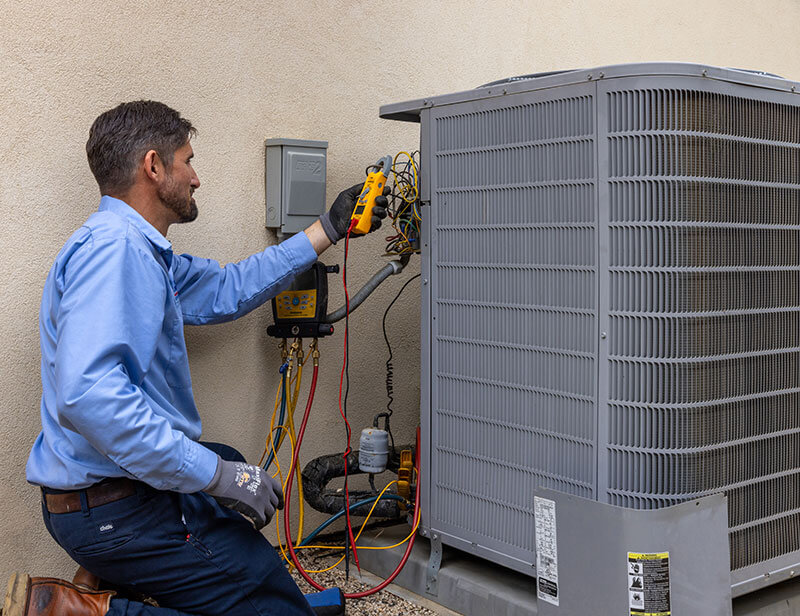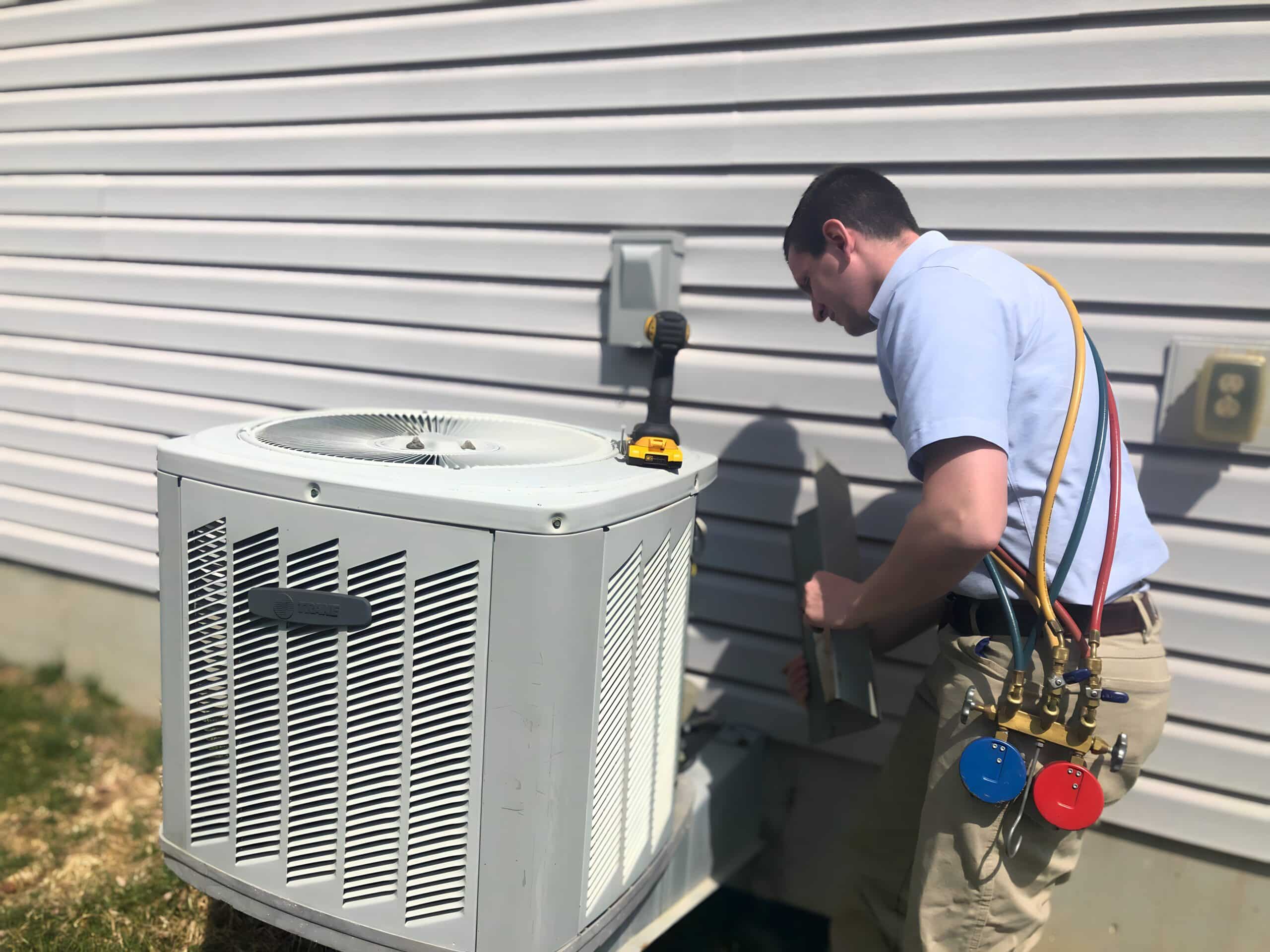heat pump service: What to Expect and Why It Matters
heat pump service: What to Expect and Why It Matters
Blog Article
How a Heatpump and Heater Collaborate to Maximize Your Home's Heating Efficiency
Recognizing exactly how a heat pump and heater collaborate is crucial for house owners seeking efficient home heating remedies. Each system has its staminas, providing a balanced approach to home convenience. The warmth pump succeeds in moderate temperature levels, while the heating system supplies rapid heat during severe cold. This harmony not only lowers energy prices however also improves the lifespan of both home appliances. What factors affect this collaboration, and just how can property owners optimize their benefits?
Comprehending Warmth Pumps: How They Function
Although lots of people might be unfamiliar with their inner workings, heat pumps play a vital role in contemporary home heating systems. These gadgets operate by moving warm from one area to another, using the concepts of thermodynamics. In colder months, a warmth pump essences warm from the outdoors air, ground, or water, and transfers it inside your home to warm up the space. Conversely, throughout warmer months, it can turn around the procedure, functioning as an air conditioning unit by eliminating heat from inside to the outside.Heat pumps contain an evaporator, compressor, condenser, and development valve. The cooling agent within the system soaks up warmth as it evaporates at low temperature levels and pressures. The compressor after that raises the pressure and temperature of the refrigerant, permitting it to launch heat as it condenses. This efficient process can substantially reduce energy usage contrasted to typical home heating techniques, making warm pumps a lasting option for environment control in homes.
The Duty of Heaters in Home Home Heating
Heating systems play a necessary function in home heating by offering a trustworthy source of warmth throughout the cooler months. They operate by generating warmth via combustion or electric resistance, dispersing it throughout the home by means of ducts or glowing systems. The performance of a heating system is typically measured by its Yearly Gas Utilization Efficiency (AFUE) rating, which shows exactly how efficiently the unit transforms fuel right into heat.Furnaces can use various power sources, including gas, oil, propane, or power, allowing home owners to choose one of the most suitable alternative for their needs. Unlike heatpump, which may battle in extreme cold, furnaces keep regular efficiency, ensuring that indoor temperatures remain comfortable no matter of outdoor problems. Additionally, modern heating systems commonly come equipped with sophisticated technology, such as wise thermostats and variable-speed blowers, boosting their efficiency and responsiveness. This versatility makes furnaces a critical element in all-encompassing home heating techniques.

Benefits of Using Both Equipments With Each Other
Integrating the staminas of both furnaces and heatpump can lead to an extra efficient and effective home heating service. Using both systems enables house owners to take advantage of the warm pump's energy efficiency during milder temperature levels while relying upon the heating system for more extreme cold problems. This twin approach can considerably reduce energy expenses, as warmth pumps eat much less electrical power than traditional home heating methods when temperature levels are moderate.Additionally, utilizing both systems with each other can improve convenience levels in the home. Heatpump can supply consistent, also heating, while heaters can rapidly elevate ambient temperatures when required. The assimilation of both systems can prolong the life-span of equipment by lowering wear and tear on each unit, as they share the workload. Eventually, home owners can enjoy a well balanced, affordable home heating solution that changes flawlessly to varying climate condition, guaranteeing a cozy and welcoming home throughout the winter season.
Exactly How Warmth Pumps and Furnaces Complement Each Other
When house owners incorporate heat pumps and heating systems, they produce a corresponding heater that optimizes efficiency and convenience. Heatpump operate by transferring warm from the outdoors air or ground, making them highly effective in modest climates. They stand out during milder temperatures, giving cost-efficient heating. Conversely, heaters generate warm via combustion or electric resistance, providing solid, immediate warmth during extreme cool conditions.The mix of these two systems enables vibrant changes based upon temperature variations. During warmer months or milder winter months days, the heatpump can take the lead, preserving power and lowering prices. As temperature levels decrease, the furnace can seamlessly involve, making certain regular heat throughout the home. This synergy not just maximizes power use but additionally boosts the life-span of both systems, as each device operates within its suitable efficiency variety. Together, they produce a well balanced atmosphere that adjusts to varying climate demands.
Optimizing Efficiency: Tips for Homeowners
Home owners can boost their heating performance with several practical methods. Establishing a regular upkeep schedule, incorporating wise thermostat technology, and applying efficient insulation and sealing remedies are essential steps. These measures not just boost comfort but likewise minimize energy costs.
Normal Upkeep Set Up
To ensure maximum home heating effectiveness, establishing a regular maintenance timetable is important for any type of home. House owners must prioritize regular evaluations of both warmth pumps and heating systems to identify peak performance. This includes transforming air filters each to three months, as stopped up filters can greatly minimize performance. Additionally, scheduling specialist maintenance a minimum of annually allows professionals to determine and resolve prospective concerns before they intensify. Property owners must also clean up the warmth pump's outside device to avoid particles build-up that can hinder airflow. By sticking to a regular maintenance routine, house owners not just enhance their furnace' performance yet also expand their life-span, resulting in higher convenience and reduced energy expenses throughout the chillier months.
Smart Thermostat Assimilation
Incorporating a wise thermostat right into a home heater can substantially improve energy performance, especially as it permits for specific control over temperature level setups. These gadgets can discover the homeowner's timetable and choices, automatically adjusting the temperature level to enhance comfort while decreasing power use. They can decrease home heating during times when the home is unoccupied, lowering unnecessary intake. Several wise thermostats also provide real-time power usage information, allowing home owners to make educated decisions concerning their home heating habits. In addition, remote gain access to via smartphone applications allows users to change settings from anywhere, ensuring the home is cozy upon return. On the whole, wise thermostat integration not only improves convenience but significantly adds to power savings and effectiveness.
Insulation and Securing Solutions
Smart thermostats play a crucial function in energy performance, however their effectiveness can be considerably boosted my latest blog post by appropriate insulation and securing options. Homeowners need to prioritize insulating wall surfaces, floors, and attics to lessen heat loss. Premium insulation materials, such as spray foam or fiberglass, can considerably boost thermal resistance. Additionally, securing gaps around home windows, air ducts, and doors avoids chilly air seepage and warmth getaway. Weatherstripping and caulking are efficient techniques for attending to these leaks - furnace replacement. Routine examinations for air leaks, together with using blower door examinations, can aid determine issue locations. By purchasing insulation and sealing, home owners can maximize the performance of their heating unit, eventually resulting in decreased energy consumption and reduced energy costs
Common Myths Regarding Warmth Pumps and Furnaces
What false impressions surround heatpump and furnaces? Several individuals mistakenly think that heatpump are inadequate in cooler environments. Actually, contemporary warm pumps are developed to operate effectively even in low temperatures, giving trustworthy heating throughout winter season. An additional common misconception is that heating systems are always a lot more effective than warmth pumps. Nevertheless, this depends on the certain power resources and effectiveness ratings of the units concerned. Some may likewise assume that using both systems simultaneously is unnecessary, but actually, this mix can enhance heating performance, specifically throughout extreme climate condition. In addition, individuals typically assume that heatpump require continuous upkeep, when in reality, they have comparable upkeep requires to traditional heating unit. By exposing these misconceptions, homeowners can make more educated choices regarding their heating choices, eventually leading to improved comfort and power efficiency in their homes.
Maintenance Factors To Consider for Combined Solutions

Often Asked Inquiries
Can Warmth Pumps Work Properly in Extremely Cold Climates?
Heatpump can struggle in incredibly chilly environments because of lowered efficiency and heat removal restrictions. see it here However, developments in innovation have actually led to versions made for much better efficiency in such conditions, boosting their practicality in severe atmospheres.
How Much Time Do Heat Pumps and Furnaces Normally Last?
Heat pumps normally last 15 to 20 years, while furnaces have a life expectancy of 15 to thirty years. Normal upkeep can expand their long life, making certain efficient operation and decreasing the need for premature replacements.

What Is the Typical Expense of Putting Up Both Equipments?
The average cost of installing both a warmth pump and a heater generally ranges in between $5,000 to $10,000 - heat pump installation ooltewah tn. Elements affecting this cost consist of system dimension, installation complexity, and local labor rates
Exist Tax Rewards for Utilizing Energy-Efficient Home Heating Equipments?
Lots of home owners ask about tax obligation incentives for energy-efficient heating unit. Numerous federal and state programs often supply rebates or credit reports, encouraging the fostering of sustainable innovations to lower power consumption and advertise ecological obligation.
Exactly how Do I Choose the Right Dimension Warm Pump and Furnace?
Selecting the ideal dimension heatpump and furnace entails calculating the home's square video, thinking about insulation high quality, and assessing local climate. Consulting an expert can ensure ideal system efficiency and power performance based upon certain requirements. heat pump service. Comprehending exactly how a warm pump and heater work together is vital for property owners seeking reliable home heating services. In colder months, a warm pump extracts warmth from the outdoors air, ground, or water, and transfers it inside to heat the living room. When home owners incorporate warmth pumps and heating systems, they create a corresponding home heating system that takes full advantage of performance and comfort. Warmth pumps run by transferring heat from the outside air or ground, making them very efficient in moderate climates. Warmth pumps can struggle in extremely chilly environments due to lowered efficiency and warmth removal restrictions
Report this page